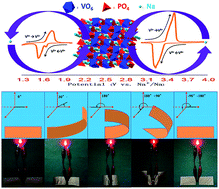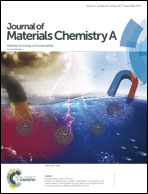A flexible symmetric sodium full cell constructed using the bipolar material Na3V2(PO4)3†
Abstract
Na3V2(PO4)3 (NVP) is considered a promising potential electrode material for both the cathode and anode in sodium ion batteries. Recently, flexible sodium ion batteries have attracted increased attention regarding their use as energy storage devices compatible with portable electronics, roll-up displays, implantable devices, and other applications. Here, a feasible strategy was adopted to prepare binder-free, mechanically robust, and paper-like carbon-coated NVP/reduced graphene oxide (NVP@C@rGO) electrodes. Combining the advantages of the large 2D rGO surface and nano-composite sandwich-like microstructure, the as-fabricated feasible NVP@C@rGO electrode demonstrated high reversible capacities and good rate capabilities both as a cathodic and as an anodic material. In addition to the half cell fabricated using a pure Na foil as the counter electrode, an interesting symmetric full cell constructed with NVP@C@rGO//NVP@C@rGO was systemically studied. The optimum design of the full cell exhibited good electrochemical performance, with 1.7 V as the output voltage plateau and a satisfactory capacity of 74.1 mA h g−1 at 0.5C. Up to 10C, this sodium full cell still exhibited stable capacity. Under arbitrary bending conditions, this flexible full cell can still exhibit a stable and safe electrochemical performance. This work may lead to a promising, low cost sodium full cell strategy for next-generation flexible energy storage devices.



 Please wait while we load your content...
Please wait while we load your content...